 |
 |
 |
 |
 |
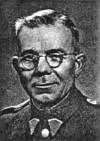 |
| Sochacki |
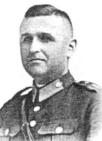 |
| Marchlewicz |
The collaborators were reviled by all sectors of the Polish underground for their collusion, their moral degradation and their participation in the persecution of the Jews. Several were executed by the underground, including the police officer Roman Swiecicki. On the other hand, many of the Granatowa Policja cooperated with the underground Armia Krajowa, and a few, like the policeman Sochacki from Przemysl, and Marchlewicz from Otwock, helped to save Jews.
As SS- und Polizeiführer für den Distrikt Lublin, Odilo Globocnik was authorised by Heinrich Himmler to form Selbstschutz (Self-Defence) units from the ranks of Volksdeutsche youths rejected by the SS. In the period November 1939 - April 1940, the Selbstschutz grew to over 12,000 men placed under the supervision of the Befehlshaber der Ordnungspolizei (BdO), the Commander of the Order Police (Orpo) in Krakow, and were used by Globocnik as his own personal police force. He moulded them into a ruthless body of ghetto clearers and perpetrators of anti-Jewish atrocities in the Lublin District. During its short but distinctive existence, the members of the Selbstschutz distinguishing themselves with their extreme brutality: shooting, raping and plundering when rounding up Poles and Jews for forced labour. The Selbstschutz were the main policing resource for the arrest and detention of Jews and Gypsies. The manner in which they operated raised such concerns among the administration of the Generalgouvernement that on 31 August 1940, the Selbstschutz was disbanded and the best recruits transferred to the Waffen-SS and the Wehrmacht. Globocnik, however, took measures to ensure that he could retain his most trusted lieutenants for the future. They were to provide the backbone of the Aktion Reinhard death camps.
Within the territories seized from the Soviet Union, the Germans utilised local police auxiliaries much more freely. These volunteers were called Hilfswillige (Auxiliaries) by the Germans, often abbreviated to "Hiwis". Those augmenting the Orpo / Ordnungpolizei (Order Police) were designated Schutzmannschaft (Protective Detachment) and eventually numbered some hundreds of thousands. The Schutzmannschaft battalions, organized by nationality, included Ukrainians, Byelorussians, Russians, Estonians, Lithuanians and Latvians. Each battalion had an authorized strength of about 500. They were moved freely around the occupied countries to engage with partisans or to kill Jews. Subsequently, as German casualties on the eastern front mounted and most Jews had been murdered, the SS raised military divisions in the Ukraine, Latvia, Lithuania and elsewhere from among these volunteers.
The Schutzmannschaft became an indispensable component in the destruction of the Jews. Everywhere they far outnumbered the equivalent German personnel. For example, in the Brest-Litovsk area of Volhynia there were 26 German gendarmerie as opposed to 308 Ukrainians. In the district of Baranovichi, there were 73 German gendarmerie and 816 native auxiliaries. By 1 July 1942 eighteen and a half Ukrainian Schutzmannschaft battalions had been formed, with a further three battalions set up in Byelorussia (Belarus) mainly staffed by Ukrainians. In places such as Zhitomir, Korosten, Kherson, Kakhovka, Uman and many others throughout the Ukraine, local militia formed part of the killing squads. The militia were paid by the municipalities, often with funds confiscated from the Jews. Ukrainians were frequently used in the shooting of the families of Jewish men, so that in Radomyshl (Radomsyl) for example, Einsatzkommando IVa could restrict itself to the killing of adult men and women. The Einsatzgruppen Operational Report USSR No.88 records that on 6 September 1941, 1,107 Jewish adults were shot in Radomyshl while the Ukrainian militia unit assisted by liquidating 561 Jewish children and youths.
 |
| v.d. Bach-Zelewski |
In all of the Einsatzgruppen reports there is but a single example of a pro-Jewish act by a member of the local population. Sonderkommando IVb reported that it had shot the mayor of Kremenchug, Senitsa Vershovsky, because he had "tried to protect the Jews." Although there were undoubtedly other unrecorded cases, it required singular bravery to aid the Jews, for to do so was to act alone and to expose both oneself and one's family to the possibility of a death sentence. In fact, most of the Ukrainian and Byelorussian population tended towards passivity so far as the murder of the Jews was concerned. But if few were on the side of the Germans, fewer still were on the side of the Jews.
 |
| Stahlecker |
By 1942 an Estonian Security Police section had been created under the command of Ain-Ervin Mere. On 5 September 1942, they were responsible for the liquidation of a transport of 1,000 people from Terezin (Theresienstadt) to Raasiku in Estonia. One week later a transport from Berlin was dealt with in similar fashion.
By early 1942, 12 full Estonian police battalions had been created. The Estonian International Commission for the Investigation of Crimes Against Humanity concluded that a number of Estonian police battalions were actively involved in the rounding up and shooting of Jews in at least one town in Byelorussia (The 36th Police Battalion participated on 7 August 1942 in the gathering together and shooting of almost all the Jews still surviving in the town of Novogrudok), and in guard duties (providing guards to prevent the escape of Jews being rounded up) in at least four towns in Poland (Lodz, Przemysl, Rzeszow, and Tarnopol). They also escorted Jews deported from Vilnius (Wilna) to camps in Estonia, and guarded the transit camp for Jews at Izbica in Poland.
In Lithuania, many Hiwis came from the ranks of "partisans", who as part of the Lithuanian National Front had started an anti-Soviet uprising at the very beginning of the German invasion. One such group of 600 commanded by a journalist, Jonas Klimaitis, murdered 3,800 Jews in Kaunas (Kovno) and a further 1,200 in other towns. From their ranks, five police companies were formed. Shortly after the German occupation of Lithuania, a reorganization of these groups occurred.
In July 1941, many units in Kaunas and elsewhere were incorporated into a paramilitary organization, the Tauto Darbo Apsauga (National Labour Guard). In Vilnius and in other places the corresponding military organization was named the Lietuvia Savisaugos Dalys (Lithuanian Self Defence). With their assistance and that of others, by the end of 1941 about 175,000 or 80% of Lithuanian Jews had been killed. A declaration issued after the war by Lithuanian Jews in the American zone in Germany concluded: "The small places in the Lithuanian provinces, without any exception, were erased by the Lithuanians." Survivor testimony concerning Lithuanian small towns and shtetls hardly mention the Germans and make it clear that Lithuanians perpetrated most of the killing, generally without the presence of any German officials. The paramilitary formations were subsequently absorbed into the Policiniai Batalionai (Lithuanian Police Battalions).
By August 1942, 20 such battalions were in existence, with a complement of 8,388 officers and other ranks. The battalions had German liason officers assigned to them and were directly subordinated to the SS-und Polizeiführer in Lithuania. After these Lithuanian Schutzmannschaft battalions had been set up, many units participated in killing operations in Byelorussia, the Ukraine and Poland. At least two companies of the Lithuanian 12th Schutzmannschaft Battalion, for example, were attached to the German 11th Reserve Police Battalion under Major Franz Lechthaler, which was sent to Minsk in the autumn of 1941. Two battalions were posted to KZ Majdanek and were responsible for executions there and in the nearby Krepiec Forest.
Hundreds of other individuals served as guards at various different camps. But even in the killing squads, it was sometimes possible to refuse to participate in shootings without suffering dire consequences. When members of the 2nd Lithuanian Schutzmannschaft Battalion were ordered to shoot Jews in the Byelorussian town of Rudensk, a young man said that he could not kill people. The Lithuanian company commander suggested that all of those who could not shoot step back. 15-17 men did so, and watched the shooting by their compatriots from a distance of 20-30 m. The battalion conducted subsequent shooting operations with less hesitation. An anti-Nazi underground Lithuanian publication asked in 1943: "Do we have to be the Arch-hangmen of Europe? The Germans who shoot Jews now will shoot us later, and the world will support them because Lithuanians are hangmen and sworn sadists."
 |
| Latvians in Warszawa * |
In 1942, Latvian police battalions were active in the Ukraine, Byelorussia and the Generalgouvernement. Among them was the Arajs Kommando, which trained at a German SD school at Fürstenberg near Berlin. Some members of this Kommando were sent to Minsk and took part in mass killings at Maly Trostinec. In Warsaw, two battalions assisted in the rounding-up of Jews for transport to Treblinka, guarding the Umschlagplatz and taking part in the suppression of the Warsaw Ghetto uprising. In time, more than 100,000 Latvians were to wear a German uniform.
Having being arrested by British occupation forces in Germany, Viktors Arajs was inexplicably released from detention in 1948 and lived peacefully in Frankfurt am Main under his wife’s maiden name for 27 years. He was apprehended in 1975 and sentenced to life imprisonment but died in 1986.
The Soviets tried 356 members of the Arajs Kommando, most of whom either received sentences of 10-25 years in the Gulag or the death penalty. A number of Latvian Auxiliary Police were also tried, but given the arbitrariness of Soviet justice, some sentences may have been too lenient and others too harsh. About 20 Liepaja auxiliary policemen were tried as members of the 20th Latvian Schutzmannschaft Battalion in the 1970's, but although many of the defendants apparently participated in the 1941 Aktionen, the indictment focused less on individual guilt than on membership of the battalion, although it at that time existed only on paper.
Karlis Ozols, a chess master born in Riga on 9 August 1912, was a leading member of the Arajs Kommando. Between 24 July 1942 and 27 September 1943 Ozols was a lieutenant in charge of a company of about 110 Latvian men stationed in Minsk. The principal tasks of the company were to guard SD installations, including the Minsk ghetto and nearby ghettos and concentration camps, to assist in the transportation and guarding of Jews selected to be killed and to guard the killing pits. They also sometimes killed the Jews at those pits. At Maly Trostinec, Ozols killed people (probably Jews) and commanded the Latvian SD guard there.
On 8 and 9 February 1943 Ozols and all of the 110 Latvians under his command assisted the Germans in killing more than 2,000 Jews of the Slutzk Ghetto after transporting them to pits outside the town. Ozols immigrated to Australia in 1949, becoming a naturalized citizen in 1956. He lived in relative anonymity in Melbourne, until in 1986 his wartime activities were exposed by an Australian journalist in a radio programme which also alleged that many Nazi war criminals had been allowed to immigrate to Australia, often with the knowledge of Australian authorities. In his 1979 testimony to German war crimes investigators, Ozols admitted his wartime role and rank and that he had been stationed at the places identified by witnesses and documents, while denying any killing of civilians. Despite the production of an overwhelming volume of evidence concerning Ozols complicity in war crimes and crimes against humanity, in 1997 Australian Attorney-General Daryl Williams announced that the case against Ozols was closed. "In the Director of Public Prosecutions' view the existing material was insufficient and the incomplete case was referred to the Australian Federal Police," a statement said. "The AFP concluded that there was little chance of success in pursuing this case to finality." Subsequent documentation suggests that the investigation was not closed due to lack of evidence as previously claimed, but instead, as a result of budgetary considerations. Ozols died on 23 March 2001 in Australia.
Another Latvian, Konrads Kalejs, was a fellow member of the Arajs Kommando and was accused of complicity in the murder of thousands of Jews. His was an extraordinary attempt to successfully avoid justice. Immigrating to Australia in 1950, he became a naturalised Australian citizen in 1957. Two years later he immigrated to the United States, where he was arrested in 1985 for misleading authorities about his past. After lengthy legal proceedings he was ordered to be deported to Australia in 1994. He then resided for a time in Australia and Canada before being arrested in 1995 in Toronto. In 1997, a Canadian enquiry found that he had assisted in the running of a slave labour camp at Salaspils (Latvia) in 1942-43, and Kalejs was deported once more to Australia.
In December 1999, the Simon Wiesenthal Centre discovered Kalejs living in a retirement home in Great Britain. During the course of 2000 he left Great Britain for Australia, where in December 2000 he was arrested in Melbourne following Latvia's request for his extradition. He died in 2001 whilst appealing against the confirmed extradition order. Despite having accepted that there was substance in the allegations against Kalejs as early as 1992, successive Australian governments failed to take any meaningful action until the signing of the extradition agreement with Latvia in 2000.
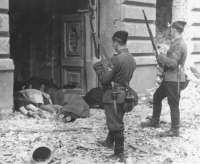 |
| Askaris in Warszawa * |
In the pre-war years, the Ukraine had been subjected to German propaganda designed to encourage the population towards self-determination and had been encouraged to perceive themselves as an ally, with the tacit suggestion that Germany would reward them once the military situation had stabilized. This deception by the Germans was for purely pragmatic reasons since they had no intention of offering the Ukrainians an independent State. Once this deception became apparent, the consequence among the ex-POW collaborators was a state of mutual mistrust and suspicion. And whilst the Germans were motivated by their policies of rabid anti-Semitism and genocide, the Ukrainians were prepared to do their "dirty work" in return for immediate and future reward. It is important to understand the difficult personal circumstances through which the Soviet auxiliaries - the majority of whom were Ukrainians - came to be involved at the heart of the genocidal activity in Aktion Reinhard.
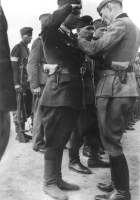 |
| Ukrainians |
"I did so for a crust of bread ... I did not think the Red Army could defeat the German Army."
Only in Trawniki were they told that they were being inducted as SS-Wachmänner (guards) for military establishments, concentration camps and operational duties in the Jewish ghettos. There was no mention of death camps. However, once the Jewish destruction commenced, the Ukrainians were liberally used in "Jewish operations" – ghetto clearances, the preparation of killing sites, execution duties, and manning the death camps. See The Case Eugenius Maytchenko.
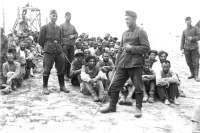 |
| Pelkinie POW Camp |
The first to die were Jewish prisoners, if they had not been shot immediately after surrender. The prisoners were kept out in the open, in a field surrounded by a high voltage fence. They were given no food for several weeks, and many starved to death.
In Pelkinie, POWs were kept in an open anti-tank ditch and after death, were either cremated before the eyes of their still living comrades or transported for cremation to nearby Koniaczow. The extreme hunger led to cases of cannibalism. As a consequence of the horrific conditions, approximately 40,000 of the POWs at Chelm Lubelski died during the winter of 1941/42. Only a few hundred of the very strong survived, and were given the option of serving the Germans.
One day at Chelm Lubelski the Germans selected 200-300 of the prisoners, including Fedorenko. They were sent to Trawniki for training. Those chosen were provided with black uniforms and given rudimentary military instruction. In the spring of 1942, Fedorenko and his colleagues were sent to Lublin to guard the ghetto. Together with 80-100 others he was subsequently transferred to Warsaw, and from there served as a guard on a transport of Jews deported to Treblinka in about September 1942. He remained in Treblinka until after the uprising in August 1943, afterwards continuing to serve the Germans as a watchman in various places. At his trial in Ft. Lauderdale (USA) in 1978, Fedorenko claimed that he was not involved in the operations at Treblinka; he only served as guard outside the camp, had no dealings with the prisoners, and never harmed anyone. But survivors testified that he had moved inside the camp, had participated in the process of dealing with arriving transports, had shot people in the Lazarett, and had been present at the gas chambers during the killings.
 |
| Marchenko |
Tadeusz Misiewicz, the Russian-speaking cashier at Belzec station, recalled many conversations he had with the ‘Blacks’ (Ukrainians) relating to happenings in the camp:
"One boasted about how he seized a young Jewish girl by the hair and beat her against a post so that her spine was broken, killing the girl instantly. When Jews were being driven into the gas chamber, one of them hit him with a piece of wood so he shot the Jew. Another Jew was tied to a post and rubbed with goose feather spines so hard that his bare bones protruded. On another occasion, the Pole, Tadeusz Sloboda, who shared a house with a Ukrainian in Belzec village, recalled that several Ukrainian guards from the camp came to his house exhausted and told him that there had been a revolt in the camp. Two wagons of Polish (non-Jewish) political prisoners arrived to be gassed. The Poles had refused to undress and ran amok. They were hunted down in the camp and shot. The guards remarked that if ever a larger transport arrived at the camp they would be unable to cope."
A West German district court described the functions of the Ukrainian auxiliaries at the first Treblinka trial in Düsseldorf in 1965:
"In addition to the group of German staff members, there were approximately 90 to 120 Ukrainian volunteers (Hilfswillige). They were mainly assigned to guard duty, but to a certain degree they were also used during the killing operations. In contrast to the Germans, they wore a black uniform and were armed with carbines or rifles; the overwhelming majority also carried long leather whips and to some extent revolvers. Further, the guard units had at their disposal machine guns and hand grenades, which were kept in a special armoury. Ukrainian troops were divided into platoons (Züge). These were commanded by ethnic Germans (Volksdeutsche), known as platoon leaders (Zugführer). The Ukrainians did mostly guard duty. However, they did not only stand guard at the camp perimeter and on the watchtowers, but under the supervision of the German brigade leaders they also guarded the various labour details inside and outside the camp. Finally, they were employed during the arrival and liquidation of transports."
Samuel Willenberg, a prisoner in Treblinka, described the Ukrainian guards in graphic terms: "The Wachmänner who guarded us were Ukrainians who had served in the Red Army and had surrendered to the Germans... While they disliked Poles, Byelorussians, Russians and Cossacks, they reserved a sizzling, boundless hatred for the Jews. The dispassionate murder of Jews was their great joy in life... Their faces were wholly devoid of even a glitter of sense or humanity; they awoke only to the sound of wild screeching, and our tragic situation did such wonders for their temperament that they would pound their thighs in glee.
These monsters were entrusted with the responsibility of guarding and murdering us, and they fulfilled these duties with expertise and limitless strength. Without getting excited or batting an eye, they were capable of murdering hundreds of human beings at a time in the Lazarett. In between transports, one of them would sit quietly on a stool and peer into the pit, rifle across his lap, as the mass of corpses – our daily harvest of blood – burned below… The Ukrainian guard would collar prisoners en route to the incinerator with papers and pocket any gold or dollars in their possession, throwing some cigarettes as payment. Explaining the transaction, he would stutter in crude, faltering Polish: 'Throw money and I give you to eat'."
The guards had many sources of income, including the warehouses containing the property of the Jewish victims, which they pilfered and bartered with the local population. Even within the confines of the camp, the Ukrainian guards supplied food and vodka to "work Jews" in exchange for cash or valuables. Delivering illegal messages from one part of the camp to the other was another source of enrichment. The Germans had no illusions about the loyalty of their Hiwis. "We were a "pile of conspirators" (verschworener Haufen) in a foreign land, surrounded by Ukrainian volunteers in whom we could not trust", said SS-Scharführer Erich Bauer, the "Gasmeister" (gassing expert) of Sobibor.
Because the Ukrainian guards were so mistrusted they were not issued with machine pistols. In Sobibor, the SS withdrew the Ukrainians' ammunition on one occasion as they suspected treachery. German fears of betrayal proved to be well founded. On 22 October 1943, while accompanying 30 Ukrainians from Sobibor to Trawniki by train, SS-Oberscharführer Herbert Floss was murdered by the guard Wasil Hetmaniec, with his own machine pistol. The other 25 guards escaped but were hunted down by the SS, arrested in Rejowiec, disarmed, manacled, and returned to Trawniki. Their fate is not known, but it is probable that they were executed. In the Aktion Reinhard camps generally, a number of Ukrainian guards were summarily shot by the SS for varying reasons. In Belzec two Ukrainians who offended Christian Wirth by loose talk to outsiders were arrested, dressed in clothing bearing the Jewish yellow star, and then gassed with the victims of the next transport. In Sobibor, two Ukrainian guards were shot in front of their comrades. In Treblinka, Wirth dealt with the Ukrainians with extreme severity, beating and whipping them into submission in a way that disturbed even the SS. Ukrainian guards sometimes collaborated with the Jewish resistance organizations, as was the case at the Plaszow forced labour camp, where over 300 Jews and sixteen Ukrainian guards escaped together, and occasionally there was also collaboration at Sobibor.
 |
| Demjanjuk |
Demjanjuk was released and returned to the United States. In 1999, the US Justice Department filed a new civil complaint against Demjanjuk, alleging that he had served as a guard at Sobibor, Majdanek and KZ Flossenbürg. A new trial commenced in 2001, at the conclusion of which it was ruled that the case against him had been proven. On 1 May 2004, a judgement was entered that Demjanjuk should be stripped of his US citizenship (again). By that time 84 years of age, Demjanjuk vowed to appeal against the ruling.
The execution of Nazi exterminatory policy was only made possible by the participation of these volunteer auxiliaries. More than 5,000 guardsmen passed through Trawniki during the two and a half years of its activity. Some were organised into two battalions, each comprising four companies of 100-200 men. One or two companies were permanently stationed in Lublin for security duties there, acting as part of the main mobile units responsible for deportations from the ghettos and the mass executions of Jews. A company-sized unit of 90-130 men was stationed at each of the Aktion Reinhard camps. Although subordinate to the Aktion Reinhard commanders and staff, the guardsmen continued to receive supplies and uniforms from, and were paid by, the Trawniki training camp. Any found unsuitable for service in the death camps for disciplinary or health reasons were sent back to Trawniki and replaced by others.
When a Jewish labour camp was constructed adjacent to the Trawniki training compound, the trainee guards were sent out on exercises, rounding up Jews in towns in the Lublin District and bringing them into the labour camp. Trawniki had become a central staging point for daily Judenaktionen ("Jewish operations"), as Wachmann Engelgard recalled:
"The final part of the training course consisted of Jews selected from the labour camp being shot individually by each Trawnikimann.".
At the conclusion of Aktion Reinhard, the majority of Ukrainians were transferred to the SS-Division "Galizien" in whose ranks they fought until defeated and destroyed by the Soviets at Brody in 1944. Writing of the Warsaw Ghetto the poet Yitzhak Katznelson commented bitterly in 1943:
"The Ukrainians and the Germans are good companions. May the very memory of these two nations be blotted from the world." A year later he was dead, gassed at Auschwitz.
Not all Wachmänner were recruited from the ranks of Soviet POWs. In 1942, Bronislaw Hajda was an 18 year-old of Polish Goralian (Highlander) descent living in the Polish town of Jordanow. Having exhausted the POW camps as a source of guardsmen, towards the end of that year the Germans began recruiting among the civilian population from the Jordanow area. Hajda was one of those recruited. He arrived at Trawniki on 9 January 1943, and having undergone the necessary training, was one of 54 guards transferred to Treblinka I, the forced labour camp situated 2 km from the death camp Treblinka II, arriving on 22 March 1943. According to guard rosters, Hajda remained in Treblinka I (work camp) until the evacuation of the camp in November 1943.
At proceedings brought against him by the U.S. Government in 1997, evidence was produced that Hajda had beaten and shot prisoners and participated in the massacre of inmates at the time of the liquidation of Treblinka I.
Trawniki was evacuated around the same time as other camps in the area, and the remaining guards became part of Batallion Streibel, named after its commandant. The Battalion's task was to force Polish civilians to build fortifications against the advancing Red Army, operating under the supervision of SS Sonderstab Sporrenberg (SS Special Staff Sporrenberg), headquartered at Jedrzejow. In January 1945, fleeing before a new Soviet offensive, the Battalion retreated to Germany, and many of its members went to Medingen, near Dresden. Hajda was listed on the Battalion's roster as late as 6 April 1945. At the war's end, he became one of the mass of displaced persons in the former Reich. In 1950 he successfully applied for entry to the United States and in 1955 became a naturalized U.S. citizen.
In common with similar legislation in other countries, the United States Immigration and Nationality Act requires revocation of citizenship illegally procured or procured by concealment of a material fact or by wilful misrepresentation.
The proceedings brought in the USA against Fedorenko, Hajda and others such as Juozas Naujalis and Mykola Wasylyk resulted in these Hiwis having their U.S. citizenship revoked where this had been falsely obtained, and their being served with deportation orders. These cases represent a tiny minority of many probable examples of former Nazis or Nazi collaborators who were granted post-war refugee status, not only in the United States, but also in Great Britain, Australia, Canada and elsewhere. For the USA, it has been estimated that as many as 100,000 or 25% of those admitted to the country after 1945 were guilty of misrepresenting their wartime affiliations and activities.
In Canada there have been a number of cases involving immigrants alleged to have obtained Canadian citizenship through fraudulent means. Amongst these and the alleged activities involved were; Helmut Oberlander (Ukrainian Volksdeutscher translator with Einsatzkommando 10a); Wasyl Odynsky (Ukrainian guard at Trawniki and Poniatowa camps); Vladimir Katriuk (Ukrainian, served with Schutzmannschaft Battalion 118); Walter Obodzinsky (Polish member of a Schutzmannschaft battalion in Turets and Mir, then served in an attack unit (Jagdzug) in Baranovichi). Some proceedings have resulted in denaturalisation being confirmed, subject to appeal. Others cases have been dismissed.
 |
| Sheptitzky |
Photos:
Latvian War Museum *
Glowna Komisja (IPN - GKBZH) *
Sources:
Hilberg, Raul. The Destruction of the European Jews, Yale University Press, New Haven, 2003
Hilberg, Raul. Perpetrators Victims Bystanders, Harper Collins, New York, 1993
Gutman, Israel, ed. Encyclopedia of the Holocaust, Macmillan Publishing Company, New York, 1990
Gilbert, Martin. The Holocaust – The Jewish Tragedy, William Collins Sons & Co. Limited, London, 1986
Arad, Yitzhak. Belzec, Sobibor, Treblinka - The Operation Reinhard Death Camps, Indiana University Press, Bloomington and Indianapolis, 1987
Willenberg, Samuel. Revolt In Treblinka, Zydowski Instytut Historyczny, Warsaw 1992
Porat, Dina. The Holocaust in Lithuania – Some Unique Aspects. In The Final Solution – Origins and Implementation, David Cesarani (ed.), Routledge, London 1996
Browning, Christopher R. Ordinary Men, HarperCollins, New York, 1993
motlc.wiesenthal.com
caselaw.lp.findlaw.com
www.join.org.au
*www.ushmm.org
www.jewishgen.org/belzec
www.jewishgen.org/galicia
www.ajn.com/kalejs
www.cjnews.com
© ARC 2005